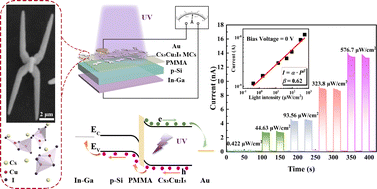Enhanced self-powered UV photodetection from X chromosome-shaped Cs3Cu2I5 microcrystals†
Abstract
Wide-bandgap lead-free copper(I) halides have attracted considerable attention in fabricating optoelectronic devices, especially for high-performance ultraviolet (UV) photodetectors (PDs). However, the metal–semiconductor–metal structures that are frequently used in the UV PDs hinder further performance improvement due to the poor separation of photo-generated carriers. In this work, we demonstrated a heterostructured self-powered UV PD using lead-free copper(I) halide Cs3Cu2I5 microcrystals (MCs) that had a curious X chromosome-shaped morphology on p-Si substrates. The X chromosome-shaped Cs3Cu2I5 MCs showed distinct blue emission at 441 nm and exhibited high stability under ambient air conditions. By introducing a thin polymethyl methacrylate (PMMA) film as modification for the interface, the heterostructured UV PD showed a remarkable responsivity of 15.2 mA W−1 for an ultralow light intensity of 0.422 μW cm−2, a specific detectivity of 8.1 × 1011 Jones, an on/off ratio of up to 4.14 × 103, and a response time of 41.43 ms/47.84 ms under 298 nm UV irradiation at zero bias. Notably, the on/off ratio was nearly 450 times higher than that of the device without X chromosome-shaped Cs3Cu2I5 MCs. The unencapsulated device exhibited extraordinary stability with no significant reduction in the photocurrent even after continuous operation for 8 hours or storage in ambient air for 60 days. Our work introduces a feasible approach that uses lead-free copper(I) halide Cs3Cu2I5 in future high-performance self-powered UV photodetection applications.

- This article is part of the themed collection: 2023 Journal of Materials Chemistry C HOT Papers


 Please wait while we load your content...
Please wait while we load your content...